Market Trends of Europe Feed Antioxidants Industry
This section covers the major market trends shaping the Europe Feed Antioxidants Market according to our research experts:
Increased Demand Due to Decreasing Livestock Population
The growing demand for livestock products has been driving significant changes on the supply side that are aimed at improving livestock product yields. New capital-intensive technologies have made the production of poultry and pig meat in industrial style production facilities possible across the region. Significant enhancements in yields of animal products have been possible even with reducing or stagnant animal headcounts. While herd sizes are being optimized across production systems, such as dairy and poultry, the investments by large groups of small-scale farmers remaining sub-par is still a challenge. This limits the growth of livestock production. However, enabling policies by various governments is expected to go a long way in maintaining or enhancing the supply, in order to meet the demand. As per the Food and Agriculture Organization, the livestock population in the region is declining year after year and in order to meet the growing demand for meat and meat products, farmers are forced to incorporate the quality compound feed substance for their livestock. Hence the decreasing livestock population in the region paves way for the growth of feed additives like feed antioxidants for the production of quality feed in the market studied during the forecast period.

Increased Compound Feed Production
The European compound feed industry has 4,000 production sites, often in rural areas, which offer few other employment opportunities in the region. Farm animals in the European Union 28 consume an estimated 478 million metric tons of feed a year, and about 30% (156 million metric tons) of it is produced by compound feed manufacturers. The rising demand for animal meat and dairy products is expected to boost the production of compound feed in the region, thereby acting as a catalyst for the feed additive market during the forecast period. Due to the changes in dietary habits and increased disposable incomes, developing countries are consuming large quantities of meat at much lower levels of the gross domestic product than in industrialized countries. This has led to higher production of compound feed, which is, in turn, driving the market for feed additives like feed antioxidants in these regions.


